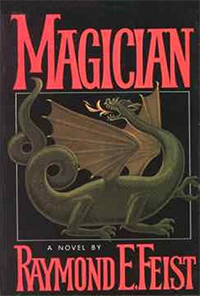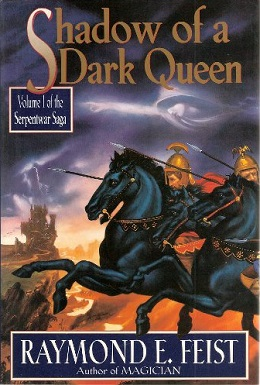
Prince Rupert of the Rhine, Duke of Cumberland, was an English-German army officer, admiral, scientist, and colonial governor. He first rose to prominence as a Royalist cavalry commander during the English Civil War. Rupert was the third son of the German Prince Frederick V of the Palatinate and Elizabeth, eldest daughter of King James VI and I of England and Scotland.

Betrayal at Krondor is an MS-DOS-based role-playing video game developed by Dynamix and released by Sierra On-Line in the summer of 1993. Betrayal at Krondor takes place largely in Midkemia, the fantasy world developed by Raymond E. Feist in his Riftwar novels. The game is designed to resemble a book, separated into chapters and narrated in the third-person with a quick-save bookmark feature.

Magician is a fantasy novel by American writer Raymond E. Feist. It is the first book of the Riftwar Saga and of the wider Riftwar Cycle. Magician was originally published in 1982. The book is set in a Dungeons & Dragons–style fantasy world called Midkemia, originally invented by Feist and his friends during college. The story follows the early life of friends Pug and Tomas as their world is overtaken by war against alien invaders who appear via portals.

The Riftwar Saga is a series of fantasy novels by American writer Raymond E. Feist, the first series in The Riftwar Cycle.

Silverthorn is a fantasy novel by American writer Raymond E. Feist, the sequel to Magician. Released in 1985, it was followed by A Darkness at Sethanon, the final book in The Riftwar Saga.

A Darkness at Sethanon is a fantasy novel by American writer Raymond E. Feist, the third and final book in The Riftwar Saga, the first series of novels in The Riftwar Cycle. It describes how Murmandamus, a new prince of the Dark Brotherhood, marshals the forces of the Moredhel and invades the kingdom, with the intent of finding the Lifestone, a powerful relic with which he will be able to destroy every living thing in the world, so as to resurrect the Valheru Lords of old. Only Pug and Tomas can stop this new evil, thereby ending the Riftwar.
Geoff Taylor is an English fantasy artist.

Violinist of Hameln is a Japanese manga series created by Michiaki Watanabe. It was published by GanGan Comics for approximately 10 years, over 37 volumes.

Into a Dark Realm is a fantasy novel by American writer Raymond E. Feist. It is the second book in the Darkwar Saga and was published in 2006. It was preceded by Flight of the Nighthawks and followed by the final book in the saga, Wrath of a Mad God.

The King's Buccaneer is a fantasy novel by American writer Raymond E. Feist. It is the second book of the Krondor's Sons series and was published in 1992. It was preceded by Prince of the Blood which was published in 1989.

Wrath of a Mad God is a fantasy novel by American writer Raymond E. Feist. It is the third and final book in the Darkwar Saga and was published in 2008. It was preceded by Into a Dark Realm which was published in 2006. It was originally meant to be published on September 3, 2007.
The Riftwar Cycle is the name given to the series of books authored or co-authored by Raymond E. Feist that revolve around the fantasy worlds of Midkemia and Kelewan.

The Serpentwar Saga is a series of fantasy novels by American writer Raymond E. Feist. The novels revolve around two characters, Erik von Darkmoor and Roo Avery and also includes a host of previous characters from past novels, including Nakor, Pug, Macros the Black, Calis and Jimmy. It tells of the struggles of the Kingdom against a massive army on the distant continent of Novindus.

Shadow of a Dark Queen is a fantasy novel by American writer Raymond E. Feist. It is the first book in The Serpentwar Saga and was first published in June 1994. It was followed by Rise of a Merchant Prince which was published in 1995.

Rise of a Merchant Prince is a fantasy novel by American writer Raymond E. Feist. It is the second book of The Serpentwar Saga, preceded by Shadow of a Dark Queen and followed by Rage of a Demon King.

Krondor: The Assassins is a fantasy novel by American writer Raymond E. Feist. It is the second book in The Riftwar Legacy and was published in 1999 by HarperCollins under their Voyager imprint. It was preceded by Krondor: The Betrayal and followed by the third book in the saga, Krondor: Tear of the Gods.

Shards of a Broken Crown is a 1998 fantasy novel by American writer Raymond E. Feist, the fourth and final book of his Serpentwar Saga and the twelfth book of his Riftwar cycle.

A Crown Imperilled is a fantasy novel by American writer Raymond E. Feist, the second in The Chaoswar Saga trilogy, which is the final saga in The Riftwar Cycle. The novel was released on January 30, 2012.
This is a complete bibliography of the works by American fantasy fiction author Raymond E. Feist.
















